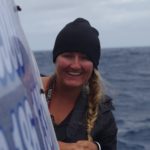 Erin Dillon is a PhD student at UC Santa Barbara studying how shark communities on coral reefs have changed over time. She graduated from Stanford University in 2014 with a B.S. in Biology and Honors in Marine Biology. Erin spent the following two years working with Dr. Aaron O’Dea as a fellow at the Smithsonian Tropical Research Institute in Panama, where she started exploring dermal denticles preserved in sediments as a paleoecological tool to reconstruct shark communities. She aims to develop this technique further as part of her dissertation to establish quantitative shark baselines and investigate spatial and temporal variation in shark assemblages on reefs. To do so, she has now set her sights on Curaçao, which is located in the southern Caribbean. There, she will work on validating the tool, explore differences in denticle assemblages between reef habitats, and provide estimates of relative shark abundance in data-limited parts of the island. Sharks are notoriously difficult to census, and it can be difficult to protect something that we rarely see. Therefore, the information provided by denticle assemblages extracted from reef sediments has critical implications for shark conservation, both in the Caribbean and worldwide. Erin is raising funds until September 22nd as part of Experiment’s Coral Reef Grant Challenge to unravel a pre-historical baseline of Caribbean sharks.
Erin Dillon is a PhD student at UC Santa Barbara studying how shark communities on coral reefs have changed over time. She graduated from Stanford University in 2014 with a B.S. in Biology and Honors in Marine Biology. Erin spent the following two years working with Dr. Aaron O’Dea as a fellow at the Smithsonian Tropical Research Institute in Panama, where she started exploring dermal denticles preserved in sediments as a paleoecological tool to reconstruct shark communities. She aims to develop this technique further as part of her dissertation to establish quantitative shark baselines and investigate spatial and temporal variation in shark assemblages on reefs. To do so, she has now set her sights on Curaçao, which is located in the southern Caribbean. There, she will work on validating the tool, explore differences in denticle assemblages between reef habitats, and provide estimates of relative shark abundance in data-limited parts of the island. Sharks are notoriously difficult to census, and it can be difficult to protect something that we rarely see. Therefore, the information provided by denticle assemblages extracted from reef sediments has critical implications for shark conservation, both in the Caribbean and worldwide. Erin is raising funds until September 22nd as part of Experiment’s Coral Reef Grant Challenge to unravel a pre-historical baseline of Caribbean sharks.
Sharks are important players on coral reefs. However, understanding the temporal and spatial dynamics of shark communities and how they are affected by human activities is challenging. Surveys and fisheries catch statistics reveal that shark populations worldwide have suffered significant declines over the past several decades due to overfishing and habitat degradation. But how many sharks should there be in a healthy coral reef ecosystem? The answer to this question is locked in the past. To address this issue, we turn to the recent fossil record to uncover clues about the sharks that used to roam the reefs of lore and paint a picture of how their communities have changed over time.
Read More “Help crowdfund shark research: time traveling through shark skin” »



